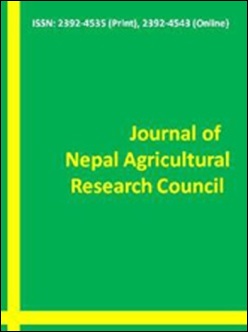Wheat Yield Trend and Soil Fertility Status in Long Term Rice-Rice-Wheat Cropping System
DOI:
https://doi.org/10.3126/jnarc.v1i0.15720Keywords:
FYM, inorganic, long term, organic and rice-rice-wheatAbstract
A long-term soil fertility experiment under rice-rice-wheat system was performed to evaluate the long term effects of inorganic fertilizer and manure applications on soil properties and grain yield of wheat. The experiment began since 1978 was laid out in randomized complete block design with 9 treatments replicated 3 times. From 1990 onwards, periodic modifications have been made in all the treatments splitting the plots in two equal halves of 4 x 3 m2 leaving one half as original. In the original treatments, recent data revealed that the use of Farm Yard Manure (FYM) @10 t ha-1 gave significantly (P≤0.05) higher yield of 2.3 t ha-1 in wheat, whereas control plot gave the lowest grain yield of 277 kg ha-1. Similarly, in the modified treatments, the use of FYM @10 t ha-1 along with inorganic Nitrogen (N) and Potassium oxide (K2O) @ 50 kg ha-1 produced significantly (P≤0.05) the highest yield of 2.4 t/ha in wheat. The control plot with an indigenous nutrient supply only produced wheat yield of 277 kg ha-1 after 35th year completion of rice-rice-wheat system. A sharp decline in wheat yields was noted in minus N, phosphorus (P), Potassium (K) treatments during recent years. Yields were consistently higher in the N:P2O5:K2O and FYM treatments than in treatments, where one or more nutrients were lacking. The application of P2O5 and K2O caused a partial recovery of yield in P and K deficient plots. There was significant (P≤0.05) effect of use of chemical fertilizers and manure on soil properties. The soil analysis data showed an improvement in soil pH (7.8), soil organic matter (4.1%), total N content (0.16%), available P (503.5 kg P2O5 ha-1) and exchangeable K (137.5 kg K2O ha-1) in FYM applied treatments over all other treatments. The findings showed that the productivity of the wheat can be increased and sustained by improving nutrient through the integrated use of organic and inorganic manures in long term.
Journal of Nepal Agricultural Research Council Vol.1 2015 pp.21-28
Downloads
Downloads
Published
How to Cite
Issue
Section
License
This license enables reusers to distribute, remix, adapt, and build upon the material in any medium or format for noncommercial purposes only, and only so long as attribution is given to the creator.

